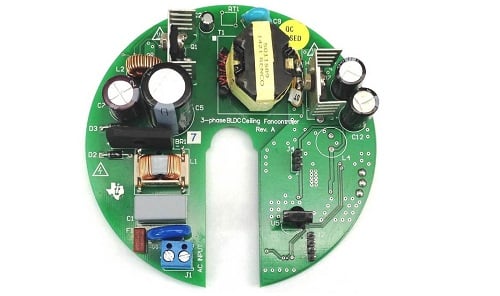This reference design is of a remote-controlled BLDC motor driver for ceiling fan application. The design offers higher efficiency and silent operation compared to a conventional fan.

The reference design is for a brushless DC (BLDC) ceiling fan which can be controlled using most off-the-shelf IR remotes. The reference design can work over a wide range of input voltage ranging from 90VAC – 265 VAC. Unlike the existing induction motors used in conventional fans, the BLDC motors do not have brushes so they last longer. Furthermore, this reference design with BLDC motors provides a higher torque/power-to-weight ratio, run efficiently and silently compared to brushed DC motors.
The reference design employs a DRV10983 24-V three-phase motor driver to drive motors with sinusoidal current and sensorless control. The reference design features a MSP430G2201 value-line processor that enables remote control by decoding infrared signals. The included firmware allows easy integration with standard infrared remotes based on the NEC transmission protocol.
The reference design has an efficiency of over 85%. The final product employing this reference design consumes 30-35 watts per hour unlike the 80-100watt required by conventional fans. In the design, overall system efficiency is governed by three-major system blocks, first is the BLDC motor itself including blades, the second is the three-phase DC/AC stage and the third is the AC-DC stage.
Features
• Sinusoidal sensor-less control at 25 kHz for minimized torque ripple and audible noise
• Universal AC operating voltage range 90 Vac to 265 Vac
• Tightly regulated 24V dc achieves ±1% speed regulation throughout input voltage range
• AC switching produces only 0.6 % ripple on 24 Vdc for optimal acoustic performance
• AC/DC efficiency is >85% at all load and line conditions to meet stringent energy efficiency requirements
This reference design has been tested by TI. The company has also provided additional resources such as schematics, Gerber files, etc. You can find additional data about the reference design on the company’s website. To read more about this reference design click here.







